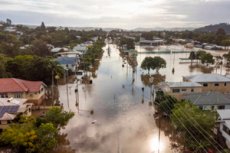Nye publikasjoner
Flom fører til en økning i antall tilfeller av leptospirose
Sist anmeldt: 02.07.2025

Alt iLive-innhold blir gjennomgått med medisin eller faktisk kontrollert for å sikre så mye faktuell nøyaktighet som mulig.
Vi har strenge retningslinjer for innkjøp og kun kobling til anerkjente medieområder, akademiske forskningsinstitusjoner og, når det er mulig, medisinsk peer-evaluerte studier. Merk at tallene i parenteser ([1], [2], etc.) er klikkbare koblinger til disse studiene.
Hvis du føler at noe av innholdet vårt er unøyaktig, utdatert eller ellers tvilsomt, velg det og trykk Ctrl + Enter.

En fersk studie publisert av forskere ved ITC-fakultetet i International Journal of Health Geographics fant at flom fører til en økning i tilfeller av leptospirose.
Førsteforfatteren, John Ifejube, er nyutdannet fra masterprogrammet i romlig ingeniørfag. Denne publikasjonen er et direkte resultat av masteroppgaven hans i geohelse.
Flom er en klimarelatert katastrofe som ikke bare påvirker miljøet, men også menneskers velvære. Leptospirose er en blodinfeksjon forårsaket av bakterien Leptospira. Folk blir smittet gjennom kontakt med forurenset vann eller urin.
Smittede personer kan utvikle hodepine, muskelsmerter og feber, men alvorlige former kan føre til nyresvikt. Et økende antall studier har knyttet spredning av leptospirose til flom, men frem til nå har dette ikke blitt grundig studert.
Masteroppgave For masteroppgaven sin utførte Ifejube en studie om forholdet mellom forekomst av leptospirose og gjentatte flom i Kerala, India. Han fant ut at flom fører til en økning i tilfeller av leptospirose. Studien hans viser at varigheten av flom er den viktigste flomkarakteristikken som kan brukes til å forutsi antall infeksjoner. I følge studien hans fører alvorlige flom til flere tilfeller av leptospirose enn moderate flom.
Han sammenlignet tilfeller av leptospirose i tre forskjellige år på tvers av tid og rom. Mer spesifikt sammenlignet han antall tilfeller i 2018 og 2019, da det var henholdsvis alvorlige og moderate flommer, med antall tilfeller i 2017, da det ikke var noen flommer.
For hvert flomår så han på rapporterte tilfeller tre måneder før, under og tre måneder etter flommen. For å vurdere flommenes alvorlighetsgrad identifiserte han befolkningen som ble utsatt for hver flom ved hjelp av satellittbilder med høy oppløsning. Til slutt brukte han romlig regresjon for å undersøke forholdet mellom tilfeller av leptospirose etter flommen og flommens omfang.
